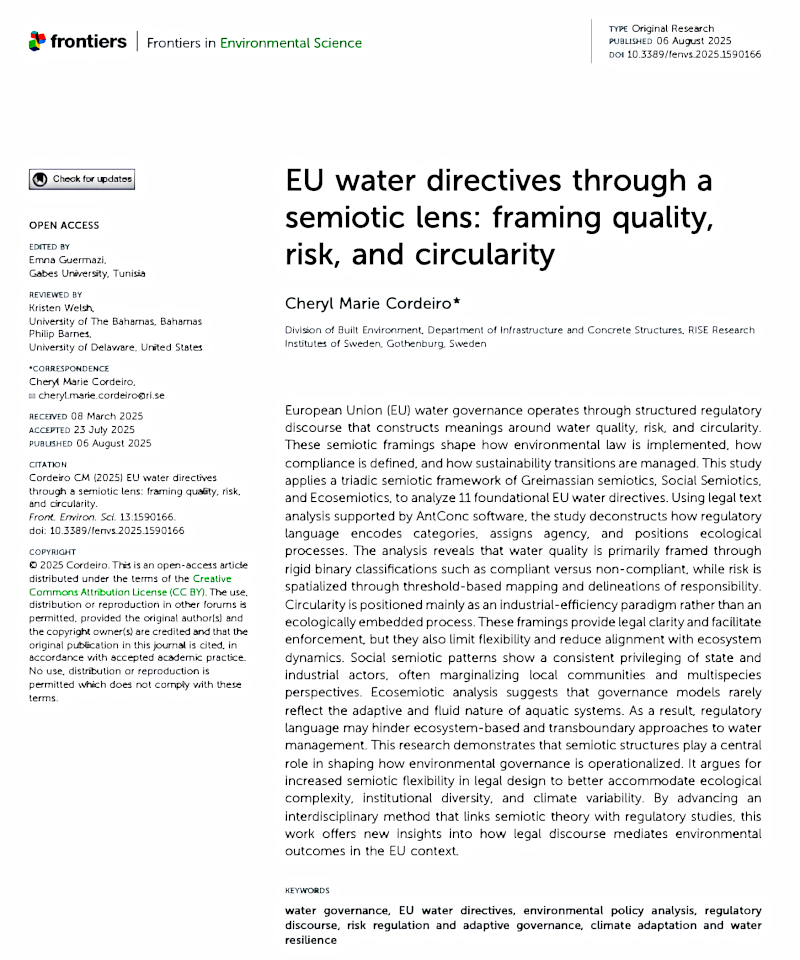
Published in Frontiers in Environmental Science, August 2025
Cordeiro, C.M. (2025). EU water directives through a semiotic lens: Framing quality, risk, and circularity. Frontiers in Environmental Science, 13:1590166.
The European Union’s water governance framework is widely recognized for its clear legal architecture, offering predictable compliance structures and harmonized standards across Member States. Yet, the language that enables this clarity and coordination may also influence how environmental concepts are interpreted and implemented. Understanding how such language constructs meaning is essential for evaluating both the strengths and limitations of EU water policy.
Beyond Compliance: The Power of Language in Policy
EU water law not only regulates environmental behavior; it also plays a constitutive role in shaping how key policy concepts such as quality, risk, and circularity, are defined and operationalized. This study applies a triadic semiotic framework, drawing on Greimassian structuralism, Social Semiotics, and Ecosemiotics, to examine 11 foundational EU water directives, including the Water Framework Directive, the Nitrates Directive, and the Water Reuse Regulation. Through this lens, the analysis explores how regulatory texts frame environmental priorities, assign agency, and embed specific worldviews that influence implementation and policy outcomes.
Key Findings
1. Binary Classifications Support Enforcement, but May Oversimplify Ecology
Legal texts often rely on binary oppositions (e.g., compliant vs. non-compliant, safe vs. unsafe) to define water quality and environmental risk. While such classifications contribute to legal clarity and enforcement consistency, they may also oversimplify dynamic ecological conditions, potentially limiting the responsiveness of governance frameworks to climate variability and local complexity.
2. Concentrated Agency and Institutional Power
Social semiotic analysis suggests that the directives tend to prioritize state authorities and industrial actors as the principal agents of compliance. In contrast, local communities, farmers, and ecosystems are frequently framed as passive recipients or as sources of risk. For example, the Nitrates Directive disproportionately attributes responsibility for pollution to agricultural actors, reinforcing top-down regulatory dynamics.
3. Narrow Framing of Circularity
Circularity, as addressed in the Water Reuse Regulation, is predominantly framed in terms of industrial water reuse and technical compliance. This technocratic framing emphasizes efficiency and risk control but tends to marginalize broader ecological regeneration processes such as aquifer recharge or wetland restoration.
4. Ecological Systems Are Underrepresented in Governance Discourse
Although some directives reference ecosystem interconnectivity – for instance, through river basin management planning – regulatory texts often treat nature as a passive context for human intervention rather than as an active participant in governance. This limits the extent to which directives align with ecosystem-based and adaptive management approaches.
Policy Implications
The findings indicate that regulatory language plays a significant role in shaping environmental governance outcomes. Several pathways for enhancing policy adaptability and ecological alignment are suggested:
- Reconsider the reliance on binary thresholds by adopting gradient-based assessments that reflect ecological variability.
- Incorporate adaptive governance models that can better respond to hydrological shifts and climate uncertainty.
- Broaden the concept of circularity to include nature-based and regenerative water management practices.
- Explore the integration of semiotic impact assessments in the policy design process, complementing existing environmental and socio-economic evaluations.
These proposals underscore the potential value of increasing semiotic flexibility in EU water governance, thereby enabling more context-sensitive, inclusive, and ecologically grounded decision-making.
Toward Meaning-Centred Water Governance
Based on this corpus-driven analysis, water governance emerges not only as a matter of technical regulation and infrastructure, but also as a process of meaning-making that shapes how societies perceive and respond to environmental challenges. This study invites policymakers, researchers, and practitioners to reflect critically on the symbolic dimensions of regulatory language – and to consider how these constructions influence both environmental outcomes and the broader trajectory of sustainability and resilience in the European context.